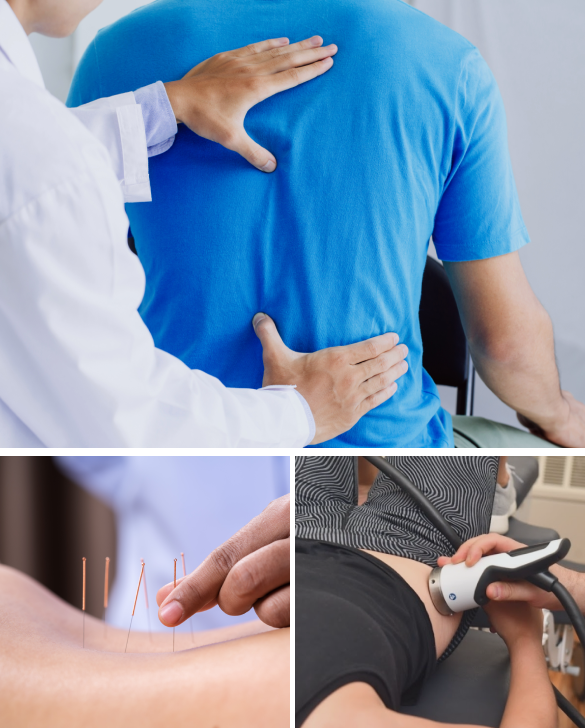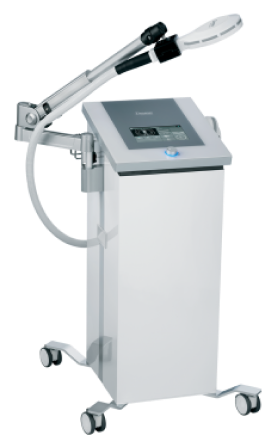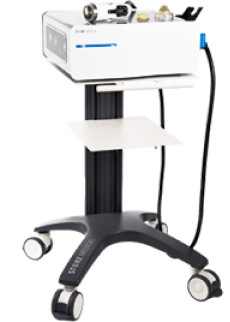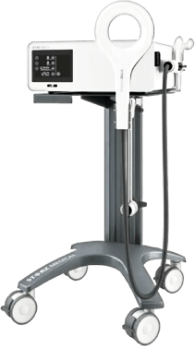The sacroiliac joint (SIJ) is a synovial joint located in the pelvis. The SIJ forms the juncture of the sacrum and the ilium, where both bones are covered with smooth cartilage that serves as a shock absorber between the spine and pelvis. The space between the bones is filled with synovial fluid to reduce friction and allow for smooth movement.
The SIJ serves to mediate load transfers between the upper and lower body during physical activity, and plays a central role in maintaining spinal and pelvic stability during walking, running and other physical activities. SIJ dysfunction is most prevalent in young and middle-aged females. The SIJ is an integral component of the entire lumbopelvic-hip complex, and cannot be treated as a stand-alone structure.
or
Dr. Kalika, clinical director at NYDNRehab, has participated in multiple interdisciplinary conferences on pelvic pain. He has studied with pelvic and SIJ health specialist Diane Lee, a renowned leader and researcher in the diagnosis and treatment of SIJ pain, and author of the most up-to-date book on SIJ treatment.
Physical therapy for pelvic pain and dysfunction requires specialized training. Dr. Kalika is a certified practitioner of the ISM (Integrated Systems Model) approach, a comprehensive and evidence-based methodology for diagnosing and treating pelvic pain. He is certified in multiple evidence-based therapy approaches for treating SIJ pain and dysfunction.
Ultrasound Guided Fascial Injection
Dr. Kalika’s expertise in diagnostic ultrasonography sets him apart from other practitioners when it comes to diagnosing and treating SI joint pain and dysfunction.
The NYDNRehab clinic features the most advanced technologies available for diagnosis and treatment of musculoskeletal injuries, pain syndromes and movement disorders.
High resolution ultrasound imaging by far surpasses MRI for viewing the SI joint. MRI is incapable of revealing information about the SI joint unless it is arthritic, which is a condition of advanced age that may not be the cause of pain. Ultrasonography allows us to visualize the SI joint in real time, with the joint in motion.
Examine the movement and stability of the SI joint
Examine the integrity of the SI ligaments
Examine the muscle attachments to SI ligaments, which are part of the force closure mechanism of the SI joint
Examine contraction of the muscles that stabilize the pelvis and SI joint in real time
Sacroiliac joint pain can be debilitating, keeping you from meeting your responsibilities and enjoying your favorite activities. Misdiagnosis and inappropriate treatment can prolong your pain and suffering, putting your life on hold while you seek a long-term solution.
The specialists at NYDNRehab understand how important it is for patients to get fast and effective treatment. We work with athletes, competitive runners and ballet dancers whose careers hang in the balance after an injury. Accurate diagnosis lays the foundation for a personalized treatment plan that gets you back to pain-free function in the shortest time possible.
We never use one-size-fits-all treatment protocols that deliver mediocre results. Our unique one-on-one personalized approach to patient care ensures that you get the exact therapy you need for a quick return to your normal daily activities.
Our extensive toolbox of high-tech equipment is rarely found in run-of-the-mill physical therapy clinics. Our dedication to providing exemplary patient care using state-of-the-art equipment makes NYDNRehab the premier clinic for SIJ physical therapy in NYC.

Low back pain below the L5 vertebra
Sensations of pain, numbness, tingling, and weakness in the lower extremities
Pain in the pelvis and buttocks
Hip and groin pain
Leg instability
Pain that disrupts sleep
Pain while sitting
Pain when getting up from sitting
Muscle imbalances that alter SIJ position
Poor lumbopelvic motor control
Pelvic misalignment
SIJ uncoupling
Ligament laxity
Trauma
Weakened core muscles
Pelvic floor dysfunction
Young to middle aged female
Pregnancy and childbirth
Obesity
Being out of shape
Because symptoms of SIJ dysfunction include pain in the low back, buttocks and legs, SIJ pain is often misdiagnosed as sciatica. An incorrect diagnosis can cost a patient time and money while prolonging or even exacerbating your pain.
Other conditions that present with the same symptoms asf SIJ dysfunction include:
Piriformis syndrome
Hip osteoarthritis
Hip femoroacetabular impingement (FAI)
Discogenic low back pain
Lumbar facet joint pain
At NYDNRehab, we use the highest resolution diagnostic ultrasound to view the structures of the pelvic region in real time, with the patient in motion. Visualizing the pelvis helps us differentiate SIJ symptoms from other conditions.
Dr. Kalika is a world-renowned expert in diagnostic musculoskeletal ultrasonography, with numerous peer-reviewed articles on the topic to his credit.


Once we accurately diagnose your SIJ condition, we have a variety of treatment options available, depending on your specific needs.
Your treatment plan may include some or all of the following:
Ultrasound guided dry needling to release deep tissue trigger points that can cause pain and impair SIJ function
Manual SI joint mobilization and chiropractic care, to restore pain-free SIJ range of motion
SI joint reeducation, to restore optimal muscle firing patterns and stabilize the SIJ
Focused shockwave therapy to alleviate pain and promote healing
Extracorporeal magneto transduction therapy (EMTT), to reduce inflammation, soothe pain and accelerate tissue repair
If you suffer from chronic pain and want fast and effective results, you need a clinic that leverages the latest technologies and therapies that really work. Run-of-the-mill physical therapy clinics often use a cookie-cutter approach to patient care that gets mediocre results.
The personalized one-on-one approach at NYDNRehab ensures that every patient is accurately diagnosed and appropriately treated. Our goal is to restore pain-free function in the least time possible, so you can get back to doing the things you love.

Regenerative therapies are new technologies making a big splash in the fields of physical therapy and chiropractic care. They work by mobilizing your body’s innate healing mechanisms, to stimulate tissue repair and encourage the progenesis of healthy new cells.

Focused Shockwave Therapy
Extracorporeal shockwave therapy (ESWT) is a highly effective treatment approach that delivers low-energy acoustic waves to the patient’s skin via a hand-held transducer under ultrasound guidance. ESWT is completely non-invasive and does not require anesthesia or pain medication. Focused shockwaves trigger the body’s innate healing mechanisms to stimulate tissue repair and reduce pain. Many patients report significant pain reduction after a single ESWT session.
Extracorporeal magnetic transduction therapy (EMTT) is a non-invasive technology that uses electromagnetic fields to reduce pain and stimulate cellular progenesis in targeted tissues. This groundbreaking new technology is an effective treatment choice for a variety of conditions, including joint pain, muscle disorders, bone fractures, athletic injuries and chronic pain conditions. As a new technology, NYDNRehab is one of the few private clinics where SIJ patients can leverage EMTT’s healing benefits.

Electromagnetic Transduction Therapy (EMTT)
The pelvic, hip and low back region share a network of nerves, muscles, bones and connective tissues that act interdependently, and conditions involving the SI joint cannot be treated in isolation. Diagnosing and resolving SIJ issues requires expertise and experience in pelvic health.
The pelvic pain specialists at NYDNRehab are experts at SI joint physical therapy and SI joint mobilization. Our knowledge and expertise, coupled with our toolbox of advanced technologies, make NYDNRehab the number one clinic for SI joint rehab in NYC. Make your appointment with an SI joint physical therapist today, and get rid of SIJ pain and dysfunction for good.
November 19, 2025
The sacroiliac joint (SIJ) is a synovial planar joint located in the pelvis. It plays an important role in load transfer during physical activity, and helps to the lower body. Dysfunction of the SIJ can cause pain in the low back and legs, which is sometimes mistaken for sciatic nerve pain.
The SIJ forms the juncture of the sacrum and the ilium. Both bones have rough surfaces that interlock to stabilize the pelvis.
Upper body force loads are transferred from the spine through the SIJ tor. The SIJ’s articular cartilage serves as a shock absorber between the spine and the pelvis, and SIJ movement facilitates hip joint range of motion.
SIJ dysfunction is most prevalent in young and middle-aged females. Pregnant women or those who have recently given birth are more likely to SIJ dysfunction.
Symptoms include:
Pain from SIJ dysfunction stems from either too little movement (hypomobility).
Causes of SIJ dysfunction include:
SIJ pain may mimic herniated disc pain, sciatica, piriformis syndrome, or gluteal myofascial syndrome, making accurate diagnosis a key facto confirm diagnosis.
The SIJ plays a central role in maintaining spinal and pelvic stability during walking, running and other physical activities. Two components of SIJ stability include structural stability which relies on the two joint surfaces being tightly linked and held in place by ligaments; and functional stability, which relies on motor control. Both aspects must be considered when devising a treatment plan.
The SIJ is an integral component of the entire lumbopelvic-hip complex, and cannot be treated as a stand-alone structure. In addition to the foot.
Normal gait and hip function are pivotal to SIJ function. Over time, a dysfunctional SIJ may become a weak link in the kinetic chain, causing pain and dysfunction elsewhere in the body.
Treatment options at NYDNR include:
Dr. Kalika has participated in multiple interdisciplinary conferences on pelvic pain. He has had the privilege of meeting Diane Lee, a foremost leader and evidence based researcher on the diagnosis and treatment of SIJ pain. Dr. Kalika is a certified practitioner of ISM (integrated systems model approach), a comprehensive and evidence based method for diagnosis and treatment of pelvic pain.
Dr. Lev Kalika is a world-recognized expert in musculoskeletal medicine. with 20+ years of clinical experience in diagnostic musculoskeletal ultrasonography, rehabilitative sports medicine and conservative orthopedics. In addition to operating his clinical practice in Manhattan, he regularly publishes peer-reviewed research on ultrasound-guided therapies and procedures. He serves as a peer reviewer for Springer Nature.
Dr. Kalika is an esteemed member of multiple professional organizations, including: